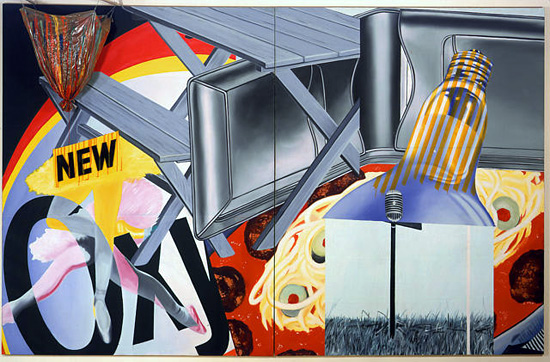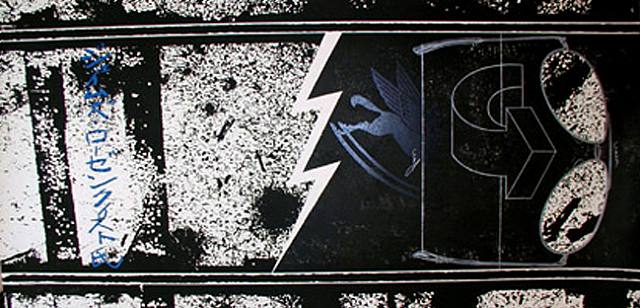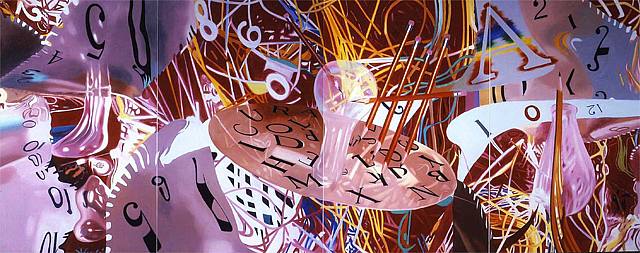|
February 3, 2008
This painting below is called Nomad. A nomad is someone who travels around from place to place and doesn't have a permanent home. Paintings usually have one part that stands out from all the others; this is called the "focal point." James Rosenquist's painting doesn't have a focal point. Our eyes just keep moving around, like a nomad.There is no single perspective:
 James Rosenquist, Nomad, 1963, Oil on canvas, plastic, and wood,
James Rosenquist, Nomad, 1963, Oil on canvas, plastic, and wood,
There are a number of his works that have multiple perspectives within a single frame and which look remarkably like photos of street art:
 James Rosenquist, Rails, 1975-6, Lithograph
James Rosenquist, Rails, 1975-6, Lithograph
We could now read the history of art, cinema, photography in terms of a fracturing of perspective and the way that the collectors cabinets of curiosity, art objects and collectables functioned less as a literal ‘window’ and more as portals to its user by housing the flotsam and jetsam of a natural/artifical world through an enframed display.
 James Rosenquist, Time Blades-Learning Curves, 2007, oil on canvas
James Rosenquist, Time Blades-Learning Curves, 2007, oil on canvas
What needs to be emphasized is the frame of viewing, not a natural or mimetic view. So the turn is to imaginative narrative mappings rather than to the production of a “window on the world”.
|

Gary, The purpose of this monumental installation (it enlarges) is to allow or enable the "viewer" to participate in the work and step, or be drawn beyond point of view, or "perspective" altogether.
1. http://www.adidabiennale.org
The work is titled Albertis Window which is a direct reference (and comprehensive critique), to/of the ground breaking work of Leon Battista Alberti who first wrote about, and formulated the "rules" for the new perspectival painting that began at the time. This perspectival revolution lead to a transformation in art and architecture and culture altogether. It also gave birth to Cartesian science, Enlightenment reason, and provided the paradigm for the modern culture of secular humanism.
The President of the Inverno in Firenze (Winter in Florence) visited the Venice exhibitiion and thereby insisted on having this work as a key feature at this years Florence exhibition. She also had the full backing of the Florence art world movers and shakers. They even went out of their way to allow/facilitate the installation of this work.
Paradoxically (maybe)It is going to be exhibited in a building in which Alberti once worked.
It is also going to be in the same room as the classic work of perspectival painting The Last Supper by Ghirlandaio.
What is also unique about this exhibit is that it is the first time that the usual Classical, Inverno In Firenze, is prominently featuring a decidely "modernist" work of art (actually four pieces). And an extraordinary one at that.